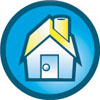Setting Up Your Home Office Internet Connection
The Internet has become a standard can't-live-without-it tool for all small businesses. Ethernet connections provide access to the internet and make operating any business significantly easier. Modern life is now so dependant on it that were the Internet to disappear overnight then most industries would screech to a grinding halt. Scary stuff!
For the home office user the Internet is still important regardless of what kind of business you might be in. Every customer expects to be able to contact you by email and ideally view your website. An email address and website have now become as common, and as important, as a business card.
Here's the first question - what kind of Internet connection do you need?
This all depends entirely on your requirements and also on what types of connections are available to you locally.
Let's look at the different types of connections first

Dialup
This is when you connect to the Internet using your phone line and an analogue modem. The current top speed for this type of connection is 56,000bps or 56k. This will be adequate for sending and receiving email and maintaining a very basic website. Dialup is quickly becoming obsolete and should only be used as a last resort. Also bear in mind that for every minute you're connected to a dialup connection you're being charged - this can add up very quickly.
Cable
Providing far higher connection speeds than dialup (up to 10Mb) cable Internet access is provided through the existing television cable that runs into your home. It provides what's called Always On connectivity which means you're connected to the Internet 24/7 for the same cost. If your business requires that you need to send and receive large email attachments or files then cable is an ideal choice. One thing to watch out for though is that if your television signal is fuzzy at times then this could indicate that your cable Internet access could also get "fuzzy" at times. Check with other people living in the area for the quality of their cable connections.
DSL
Digital Subscriber Line Internet access provides another high speed method of getting online. Operating at speeds of up to 2MB (sometimes higher) DSL connections rely on an existing telephone connection in your home. To get DSL installed you must be living a certain distance of an enabled telephone exchange (normally within 5km). Check out if you need a business DSL service or are interested in DSL connection. If you're not living within 5 kilometers, then you'll be outside DSL coverage. DSL doesn't offer the same connection speeds as cable but is less prone to problems overall. Personally I use DSL for my home office because it's the best connection choice for the area I live in.
Satellite
For those of you living outside DSL and Cable coverage then satellite may be an option for you. These packages can be quite expensive ($1,000 to setup and about $100 per month in some areas) so make sure you check exactly how much it costs in your area. Satellite connections normally provide between 1Mb and 2Mb download speeds but the upload speeds are normally much lower (256k - 512K normally). Using satellite broadband will require the fitting of a satellite dish to your house and of course any weird solar activity (solar flares for example) could disrupt your connection so bear this in mind. For those of you truly living in the middle of nowhere satellite is always, albeit a somewhat expensive, option.
Wireless
 The use of Wireless or Microwave Internet access is gaining popularity in some areas because of it's long range (up to 30km) and cheap running costs. Not to be confused with wireless networks in your office the Wireless/Microwave connections we're talking about here are transmitted directly into your home from a remote base station. Offering speeds up to 4Mb wireless is providing stiff competition for both cable and dsl companies in some parts of Europe and the US.
The use of Wireless or Microwave Internet access is gaining popularity in some areas because of it's long range (up to 30km) and cheap running costs. Not to be confused with wireless networks in your office the Wireless/Microwave connections we're talking about here are transmitted directly into your home from a remote base station. Offering speeds up to 4Mb wireless is providing stiff competition for both cable and dsl companies in some parts of Europe and the US.
One major drawback of wireless internet is that it relies on Line Of Sight to be effective. That's why most wireless/microwave transmitters are mounted on top of tall buildings or local mountains or hills. If something obstructs your line of sight to the base station then your Internet connection might be weak or just drop altogether.
So now you have an overview of the different types of Internet connections. All you need to do now is choose the one that suits you best in terms of speed and reliability and then shop around for the best bargain in your area.
What Is Voip?
Tired of paying crazy long distance or international call charge?
Skype
Cheap long distance phone calls and free internet video calls.
Registering your own domain name
Your business needs its own domain name - it's that simple.